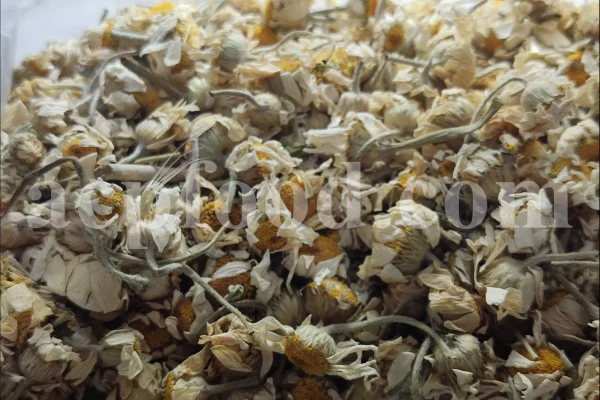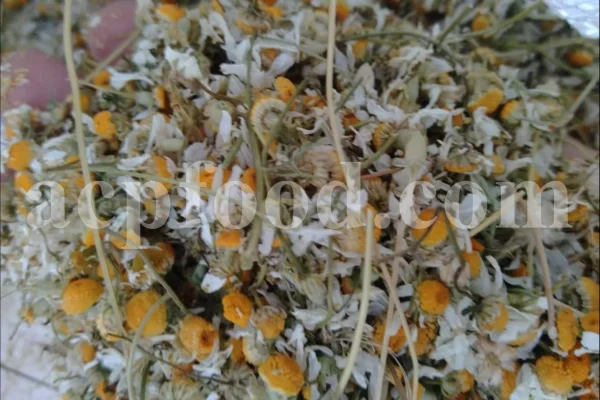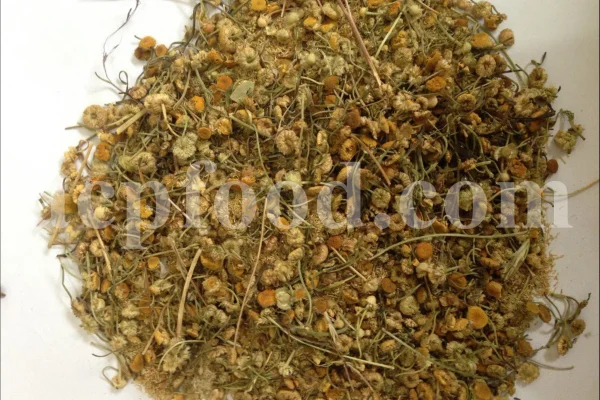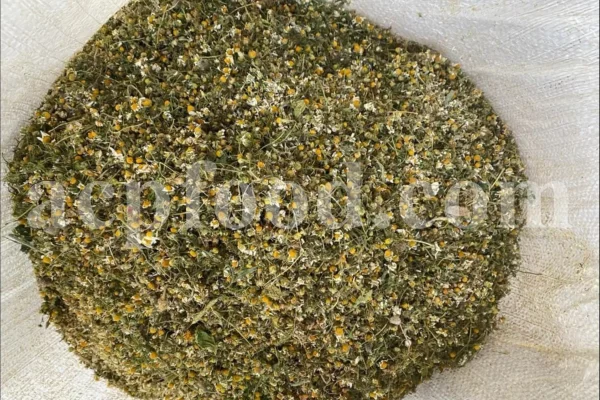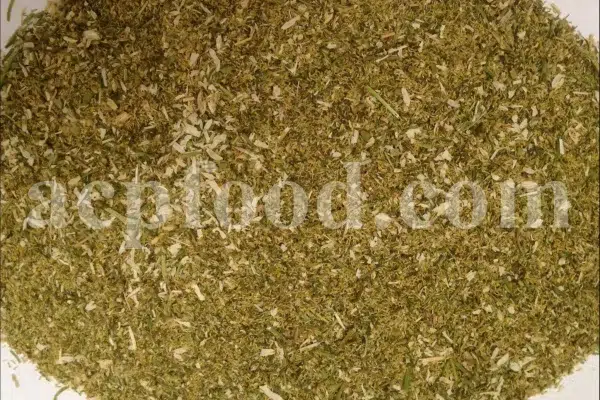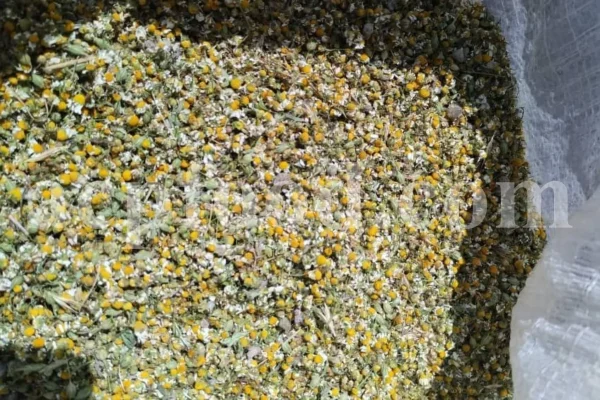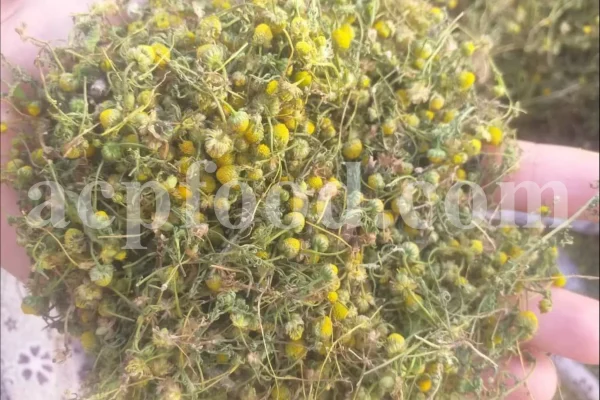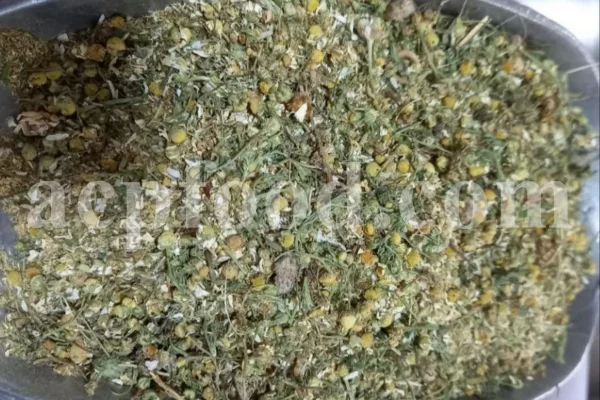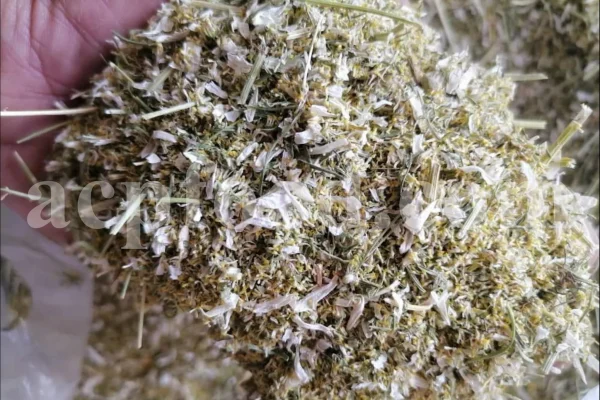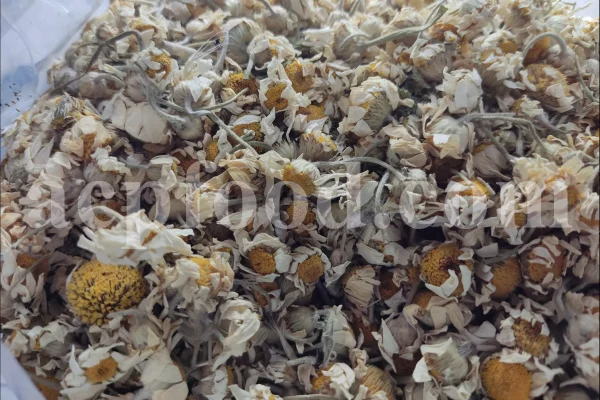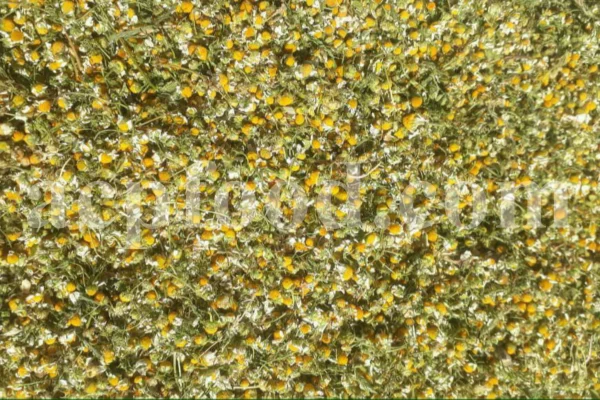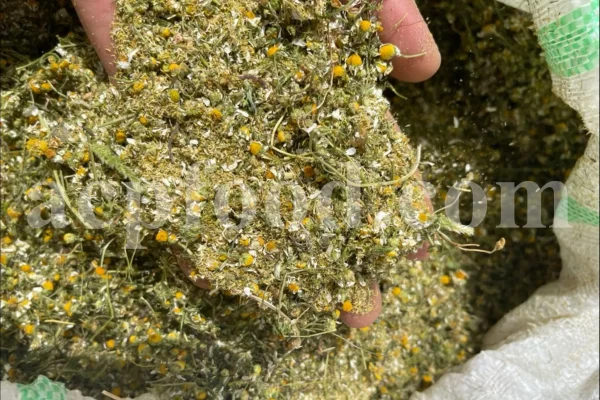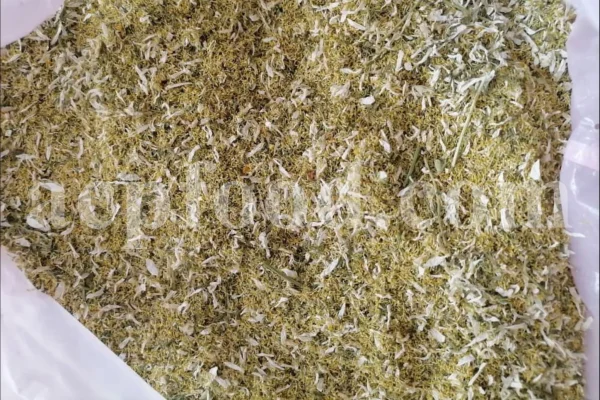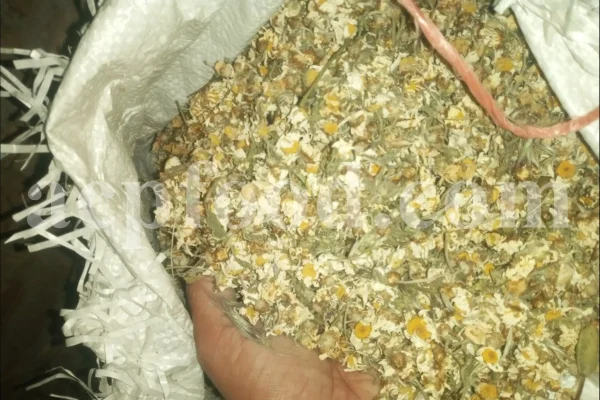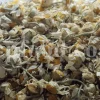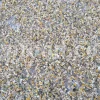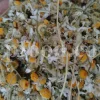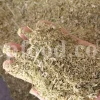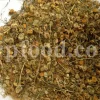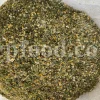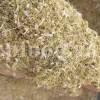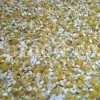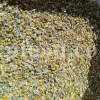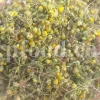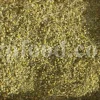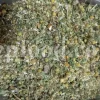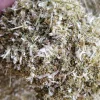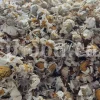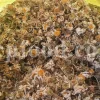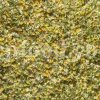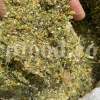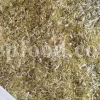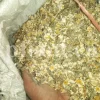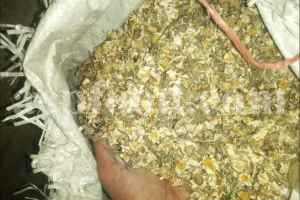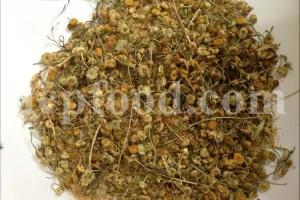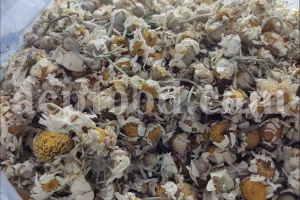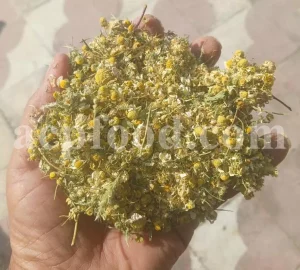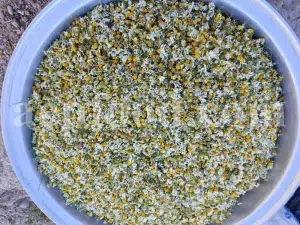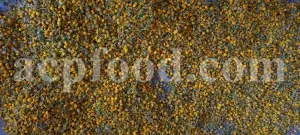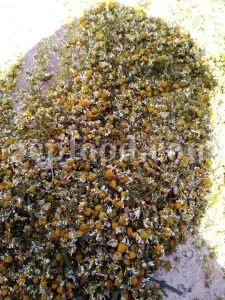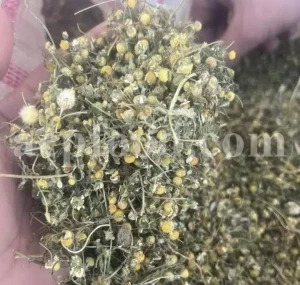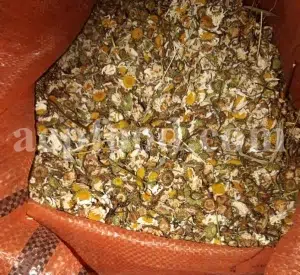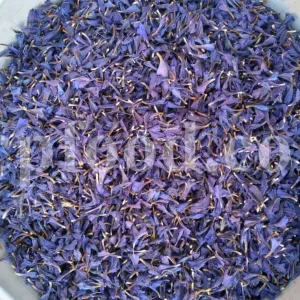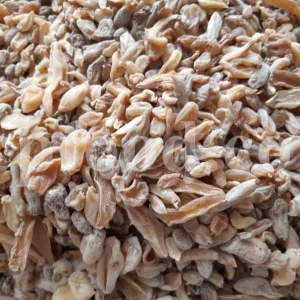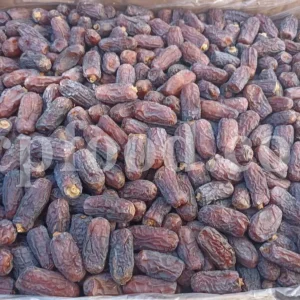1- Feverfew
2- Yellow Chamomile
3- Chamomile
4- Corn Chamomile
5- Roman chamomile
1- Common Feverfew, Feather-Leaved Tansy, Featherfew.
2- Dyer’S Chamomile, Golden Chamomile, Golden Marguerite.
3- Blue Chamomile, Common Chamomile, Crown Mayweed, German Chamomile, Hungarian Chamomile, Matricaria, Scented Chamomile, Scented Mayweed, Sweet False Chamomile.
4- Field Chamomile.
5- English chamomile, Russian chamomile, Noble chamomile.
Family: Asteraceae
GENERAL DATA
Plant parts: Flowers
Cultivation mode: Wild collection/Cultivated
In manufacturing: Pharmaceutical, beverages, cosmetics, soap, skincare, haircare, shampoo, perfumery, extract, oil, mouthwash, dyeing, hair color.
In food: Herbal Tea.
🌼 Industries That Use Feverfew Flower (Tanacetum parthenium)
Feverfew, a flowering plant in the daisy family (Asteraceae), has been traditionally used across European herbalism and modern phytotherapy for its remarkable anti-inflammatory, antimigraine, and neuroprotective effects. Its active compounds, particularly parthenolide, make it valuable in pharmaceutical, nutraceutical, and cosmetic industries.
1. Pharmaceutical & Migraine Relief Industry
Feverfew is best known as a natural migraine-prevention remedy, supported by both traditional and clinical evidence.
Applications:
-
Used to prevent chronic migraines and cluster headaches
-
Reduces vascular inflammation and prostaglandin synthesis
-
Sometimes paired with magnesium and riboflavin for migraine formulas
✅ Common forms: standardized extracts, tablets, capsules, and teas
2. Herbal & Nutraceutical Industry
Feverfew is featured in nervous system and pain-modulation formulas.
Applications:
-
Included in anti-inflammatory blends for neuralgia and arthritis
-
Used in stress-related headache support and menstrual tension blends
-
Sometimes combined with Valerian, Passionflower, or Skullcap
✅ Often standardized to parthenolide content (0.2–0.7%)
3. Women’s Health & Hormonal Support
Traditionally used for menstrual-related migraines and hormonal discomfort.
Applications:
-
Used in PMS formulations to relieve tension and cramping
-
Helps reduce menstrual-related headaches
-
Combined with Chasteberry (vitex) or Black Cohosh
✅ Provided in low-dose capsules or infusions
4. Cosmetic & Anti-Inflammatory Skincare Industry
Due to its anti-inflammatory and antioxidant profile, feverfew flower extract is incorporated into skincare.
Applications:
-
Used in anti-redness creams, sensitive-skin serums, and after-sun care
-
Known to calm irritated or reactive skin
-
Sometimes found in eczema or rosacea blends
✅ Applied as water-soluble extract in topical formulations
5. Aromatherapy & Botanical Fragrance
While not a traditional essential oil source, feverfew flowers are sometimes used in botanical infusions.
Applications:
-
Appears in herbal pillow blends or scented bath sachets
-
Used in mood-calming potpourri or dream blends
-
Sometimes infused into carrier oils for topical use
✅ Valued more for its therapeutic benefits than fragrance alone
6. Functional Tea & Ethnobotanical Use
Feverfew has long been prepared as a bitter herbal infusion.
Applications:
-
Used in bitter tea blends for headache and body tension
-
Part of folk medicine rituals in Europe for fevers and inflammation
-
Combined with German Chamomile, Lemon Balm, or Meadowsweet
✅ Must be used with caution—only small amounts recommended
✅ Summary of Key Applications
| Industry | Common Uses |
|---|---|
| Pharmaceutical & Migraine | Preventative for migraines, tension headaches |
| Herbal & Nutraceutical | Anti-inflammatory, nerve pain, stress tension |
| Women’s Health | PMS-related headache, menstrual cramping |
| Cosmetic & Skincare | Anti-redness creams, reactive skin soothers |
| Aromatherapy & Fragrance | Relaxing infusions, pillow sachets, bath blends |
| Ethnobotanical & Tea | Traditional tea for pain and fever, bitters |
🌟 Key Features
-
Contains parthenolide, flavonoids, and sesquiterpene lactones
-
Well-documented anti-inflammatory and vasomodulating activity
-
Caution advised in pregnancy and with blood-thinning medications
-
Offered in standardized capsules, dried flower, extract, and topicals
-
Widely used in migraines, menstrual support, and natural skincare
🌼 Industries That Use Yellow Chamomile (Cota tinctoria)
Yellow Chamomile, or Golden Chamomile, is a bright yellow flowering herb native to Eurasia and widely cultivated for its anti-inflammatory, antimicrobial, and colorant properties. Although it differs from true chamomile (Matricaria chamomilla or Chamaemelum nobile), Cota tinctoria is valued in phytotherapy, natural dye production, and cosmetics. It contains flavonoids, sesquiterpenes, and volatile oils, making it useful across several industries.
1. Herbal & Traditional Medicine
Though not as commonly used as German or Roman chamomile, Yellow Chamomile has notable uses in folk medicine and natural health systems.
Applications:
-
Used for digestive upset, mild cramps, and headaches
-
Sometimes prepared as a calming tea in local herbal traditions
-
Applied externally as a mild anti-inflammatory poultice
✅ Found as dried flowers, infusions, and home-brewed tonics
2. Natural Dye & Textile Industry
Cota tinctoria is historically prized as a natural yellow dye plant.
Applications:
-
Used to dye wool, silk, and cotton in yellow and golden hues
-
Popular in organic textile dyeing and botanical art projects
-
Employed in traditional crafts, especially in Central Asia and the Middle East
✅ Produces durable yellow pigments from flowers
3. Cosmetic & Personal Care Industry
Golden chamomile extracts are used for soothing and brightening skin and hair.
Applications:
-
Found in gentle cleansers, eye creams, and sensitive-skin products
-
Added to natural shampoos and blond hair lightening formulas
-
Occasionally used in herbal facial steams and bath soaks
✅ Valued for its anti-irritant and skin-brightening qualities
4. Tea & Beverage Industry (Niche)
While not as widespread as Matricaria, it is used in herbal infusions for its mild bitterness and aromatic nature.
Applications:
-
Used in floral tea blends with Lemon Balm, Mint, or Verbena
-
Sometimes labeled as golden chamomile tea for specialty markets
-
Has a slightly bitter, earthy flavor—less sweet than true chamomile
✅ Sold as dried flower or blended in calming teas
5. Ornamental & Landscaping Industry
Widely cultivated for pollinator gardens and aesthetic landscaping.
Applications:
-
Planted in flower beds, rock gardens, and low borders
-
Used in pollinator-friendly designs for bees and butterflies
-
Grown in drought-tolerant landscaping projects
✅ Hardy and aesthetically appealing with long flowering period
✅ Summary of Key Applications
| Industry | Common Uses |
|---|---|
| Herbal & Traditional Medicine | Calming tea, digestive aid, anti-inflammatory poultice |
| Textile & Natural Dye | Yellow dye for fabrics, botanical art |
| Cosmetic & Skincare | Sensitive skin formulas, eye care, hair brightening |
| Tea & Beverage | Floral tea blends, calming herbal infusions |
| Landscaping & Ornamental | Pollinator plant, garden aesthetics, eco-designs |
🌟 Key Features
-
Rich in flavonoids, terpenes, and natural pigments
-
Milder effects than German/Roman chamomile but still beneficial
-
Offers bright golden flowers—used both medicinally and decoratively
-
Excellent for natural dyeing, mild skincare, and garden use
-
Not interchangeable with Matricaria or Chamaemelum, but complementary
🌼 Industries That Use Chamomile (Matricaria chamomilla L.)
German Chamomile is a powerful medicinal flower revered for its anti-inflammatory, antispasmodic, mild sedative, and digestive-soothing effects. Rich in chamazulene, apigenin, and bisabolol, it is a cornerstone herb in pharmaceutical, nutraceutical, cosmetic, and tea industries. It has also been widely adopted in baby care, dermatology, and oral hygiene formulations.
1. Pharmaceutical & Medicinal Industry
Chamomile is used as a natural remedy for numerous internal and topical conditions.
Applications:
-
Digestive aid: eases bloating, cramps, and indigestion
-
Antispasmodic: used in colic, irritable bowel, and menstrual pain remedies
-
Mild sedative: supports anxiety, insomnia, and nervous restlessness
-
Anti-inflammatory: used for sore throat, ulcers, and wound care
✅ Available in tinctures, capsules, syrups, extracts, and suppositories
2. Herbal & Nutraceutical Industry
Chamomile is foundational in natural wellness and relaxation products.
Applications:
-
Found in sleep and relaxation formulas
-
Used in gut-brain axis blends for digestion and mood
-
Common in adaptogenic and stress-support supplements
✅ Often paired with Lemon Balm, Valerian, or Lavender
3. Tea & Beverage Industry
Chamomile tea is among the most consumed herbal teas globally.
Applications:
-
Used in sleep-promoting and calming teas
-
Combined with mint, rose, cinnamon, or citrus peels
-
Appears in ready-to-drink wellness beverages and botanical sodas
✅ Available as loose-leaf, tea bags, extracts, and concentrates
4. Cosmetic & Personal Care Industry
Chamomile is highly regarded in dermocosmetics and gentle skincare.
Applications:
-
Used in soothing creams, lotions, and balms
-
Key ingredient in baby care, eczema, and sunburn relief products
-
Common in shampoos and conditioners for sensitive scalp
✅ Rich in bisabolol and azulene, known for anti-inflammatory and healing effects
5. Oral Care & Baby Products
Chamomile’s gentle and safe nature makes it ideal for oral hygiene and infant formulas.
Applications:
-
Found in teething gels, gripe water, and calming drops
-
Used in natural toothpastes, mouthwashes, and throat sprays
✅ Safe for infants and elderly when properly formulated
6. Aromatherapy & Essential Oil Industry
Chamomile essential oil is one of the most therapeutically active oils available.
Applications:
-
Used in aromatherapy for relaxation, stress, and sleep
-
Applied topically in pain relief oils and massage blends
-
Valuable in diffuser oils, inhalers, and skincare serums
✅ German Chamomile oil is deep blue due to chamazulene content
7. Veterinary & Animal Care
Used in calming supplements and grooming products for pets.
Applications:
-
Found in dog shampoos, calming treats, and digestive blends
-
Applied in equine care for stress and skin irritations
✅ Especially valued in natural pet wellness
✅ Summary of Key Applications
| Industry | Common Uses |
|---|---|
| Pharmaceutical | Digestive aid, anti-inflammatory, sedative |
| Herbal & Nutraceutical | Sleep support, gut health, calming formulas |
| Tea & Beverage | Sleep teas, digestive infusions, functional drinks |
| Cosmetic & Skincare | Baby care, eczema creams, soothing serums |
| Oral & Baby Care | Teething gels, gripe water, mouth sprays |
| Aromatherapy | Stress relief, massage oil, sleep blends |
| Veterinary Health | Calming pet products, anti-itch shampoos |
🌟 Key Features
-
Rich in apigenin, chamazulene, bisabolol, and flavonoids
-
One of the most studied medicinal flowers in the world
-
Known for its gentle action and wide safety margin
-
Available in dried flower, essential oil, extract, and tincture forms
-
Approved by the European Medicines Agency (EMA) for multiple indications
🌼 Industries That Use Corn Chamomile (Anthemis arvensis L.)
Corn Chamomile (Anthemis arvensis), also known as Field Chamomile or Mayweed, is a wildflower species in the Asteraceae family that shares visual similarities with German and Roman chamomile but differs chemically and therapeutically. Traditionally used in folk medicine, it offers mild anti-inflammatory, digestive, and skin-soothing properties, though less potent than Matricaria chamomilla. It is valued in herbal teas, cosmetics, ethnobotany, and pollinator-friendly agriculture.
1. Herbal & Traditional Medicine
Historically used in rural and folk remedies as a digestive and calming herb.
Applications:
-
Mild aid for digestive discomfort and cramping
-
Used in infusions for relaxation and skin conditions
-
Applied externally for minor wounds and eye compresses
✅ Found as dried flower, herbal poultices, or infused oils
2. Cosmetic & Personal Care Industry
Although milder than Matricaria, Anthemis arvensis is used in natural skincare for sensitive skin.
Applications:
-
Used in gentle cleansers and baby lotions
-
Sometimes included in after-sun care, eczema relief, or mild anti-itch products
-
Appears in herbal facial steams and botanical soaps
✅ Delivered as flower water, extract, or whole inflorescence powder
3. Herbal Tea & Beverage Industry
Field chamomile is used in folk-style herbal teas, especially in rural European and Mediterranean traditions.
Applications:
-
Consumed as a relaxing evening tea
-
Blended with mint, linden, lemon balm, or fennel
-
Sometimes mislabeled as common chamomile in local markets
✅ Less sweet and more earthy or bitter than true chamomile
4. Ethnobotanical & Organic Farming
Corn chamomile is relevant in ethnobotanical research and as a pollinator plant in biodynamic agriculture.
Applications:
-
Grown to support bee populations in organic farming
-
Used in eco-landscaping and wildflower seed mixes
-
Sometimes studied for sustainable herbal applications
✅ Also functions as a soil cover crop and weed competitor
5. Animal & Veterinary Use (Folk)
In traditional settings, field chamomile has been used as a natural herb for livestock.
Applications:
-
Mixed in poultry and goat feed for digestion and stress
-
Used in herbal rinses for animal skin irritation
-
Offered to animals in herbal forage systems
✅ Rare in modern veterinary products but retained in local practice
✅ Summary of Key Applications
| Industry | Common Uses |
|---|---|
| Herbal & Folk Medicine | Calming infusions, poultices, digestive tonic |
| Cosmetic & Skincare | Sensitive skin washes, baby lotions, botanical soaks |
| Tea & Beverage | Traditional herbal teas, blends with other calming herbs |
| Ethnobotanical & Agriculture | Bee-friendly plant, wildflower mixes, study of traditional use |
| Animal Health (Folk) | Herbal feed for poultry/goats, rinses for skin support |
🌟 Key Features
-
Contains low levels of apigenin, sesquiterpene lactones, and volatile oils
-
Milder action than German or Roman chamomile
-
Recognized for gentle, supportive effects, especially in folk systems
-
Often found growing wild in grain fields, hence the name “corn” chamomile
-
Suitable for basic teas, botanical extracts, and topical calming preparations
🌼 Industries That Use Roman Chamomile (Chamaemelum nobile)
Roman Chamomile is a fragrant, low-growing perennial herb from the Asteraceae family, known for its calming, antispasmodic, and anti-inflammatory properties. Though chemically distinct from German Chamomile (Matricaria chamomilla), it shares many therapeutic uses and is highly valued in pharmaceutical, aromatherapy, cosmetic, and baby care industries. Its key constituents include esters (like angelates), chamazulene, and flavonoids, making it gentler and more relaxing in its action.
1. Pharmaceutical & Medicinal Industry
Roman chamomile is used as a mild sedative, digestive relaxant, and anti-inflammatory.
Applications:
-
Helps with nervous system tension, insomnia, and restlessness
-
Eases digestive upset, nausea, and intestinal cramping
-
Used in topical products for inflammatory skin conditions
✅ Found in capsules, herbal drops, syrups, and topical gels
2. Aromatherapy & Essential Oil Industry
Roman Chamomile essential oil is highly valued for its calming, sweet aroma and emotional balancing effects.
Applications:
-
Used in stress-relief, sleep blends, and mood-lifting oils
-
Common in massage oils, baby care blends, and diffuser formulas
-
Known to reduce irritability and mental fatigue
✅ Contains up to 80% esters (e.g., isobutyl angelate), giving it a soft, soothing profile
3. Cosmetic & Personal Care Industry
Due to its anti-irritant and soothing properties, Roman chamomile is widely used in skincare.
Applications:
-
Found in anti-redness creams, eczema lotions, and sensitive-skin serums
-
Common in aftershave balms, makeup removers, and cleansers
-
Used in baby wipes, creams, and natural shampoos
✅ Offered in essential oil, hydrosol, and extract form
4. Baby Care & Pediatric Products
Roman Chamomile is considered exceptionally safe for infants and children, making it a go-to herb in natural pediatric care.
Applications:
-
Added to teething gels, diaper creams, and gripe water
-
Used in baby massage oils, bedtime sprays, and bath blends
-
Helps ease colic, fussiness, and minor skin irritation
✅ Preferred over German chamomile for sensitivity-prone skin
5. Herbal Tea & Beverage Industry
Though less common than German Chamomile, Chamaemelum nobile is used in calming herbal teas.
Applications:
-
Used as a sleep aid and digestive relaxant
-
Combined with Rose petals, Lavender, or Lemon Balm
-
Offers a milder, apple-like flavor compared to Matricaria
✅ Available in loose-leaf, sachets, and botanical blends
6. Ornamental & Landscape Use
As a low-growing, fragrant groundcover, Roman Chamomile is popular in natural landscaping.
Applications:
-
Used in chamomile lawns, walkways, and scented gardens
-
Attracts bees and pollinators
-
Ideal for medicinal or sensory gardens
✅ Sometimes called “Lawn Chamomile” for its carpeting growth habit
✅ Summary of Key Applications
| Industry | Common Uses |
|---|---|
| Pharmaceutical | Mild sedative, digestive relaxant, skin anti-inflammatory |
| Aromatherapy | Emotional calming, sleep support, stress relief |
| Cosmetic & Skincare | Sensitive skin care, eczema, baby products |
| Baby Care | Gripe water, diaper rash cream, teething support |
| Tea & Beverage | Calming teas, sleep aids, herbal blends |
| Ornamental Landscaping | Fragrant groundcover, bee-friendly gardens |
🌟 Key Features
-
High in esters (e.g., isobutyl angelate), flavonoids, and chamazulene
-
Gentler and sweeter in aroma than Matricaria chamomilla
-
Excellent for children, sensitive individuals, and emotional wellness
-
Delivered in essential oil, hydrosol, dried flower, and extract formats
-
Prominent in calming, pediatric, and gentle skincare formulas
🌼 Comparison of Chamomile & Related Species
| Aspect | Feverfew(Tanacetum parthenium) | Yellow Chamomile(Cota tinctoria) | German Chamomile(Matricaria chamomilla) | Corn Chamomile(Anthemis arvensis) | Roman Chamomile(Chamaemelum nobile) |
|---|---|---|---|---|---|
| Family | Asteraceae | Asteraceae | Asteraceae | Asteraceae | Asteraceae |
| Botanical Group | Tanacetum genus | Cota (Anthemideae) | Matricaria genus | Anthemis genus | Chamaemelum genus |
| Growth Habit | Perennial, bushy | Annual or biennial | Annual, upright | Annual, wildflower | Perennial, low-growing |
| Main Constituents | Parthenolide, sesquiterpene lactones | Flavonoids, apigenin derivatives | Chamazulene, apigenin, bisabolol | Sesquiterpene lactones (low), flavonoids | Isobutyl angelate, bisabolol, chamazulene |
| Aroma Profile | Sharp, slightly bitter | Bitter, earthy | Sweet, apple-like | Earthy, grassy | Sweet, apple-like, milder than German |
| Traditional Uses | Migraine prevention, inflammation | Dye plant, mild calming tea | Sleep, digestion, skin health | Digestive aid, skin wash | Mild sedative, child-safe remedy |
| Medicinal Strength | High (especially for migraines) | Mild | Strong (pharmacologically studied) | Mild | Moderate, gentle and safe |
| Tea Use | Rarely used (bitter) | Occasionally used | Widely used | Limited/local use | Common in calming blends |
| Skincare Use | Rare | Yes (natural coloring & mild calming) | Strong anti-inflammatory | Yes (mild) | Excellent for sensitive skin |
| Essential Oil | Not typically extracted | Rare | Yes (blue oil with chamazulene) | Rare | Yes (sweet, calming, pale yellow oil) |
| Primary Industries | Pharmaceutical, nutraceutical | Natural dye, cosmetics, folk tea | Pharmaceutical, tea, cosmetic, aromatherapy | Herbal tea, cosmetic, rural tradition | Baby care, aromatherapy, cosmetics |
| Color of Flowers | White petals, yellow disc | Bright yellow | White petals, yellow disc | White petals, yellow disc | White petals, yellow disc |
✅ Summary Notes
1. Feverfew (Tanacetum parthenium)
-
Best known for migraine prevention and vascular inflammation relief
-
Not traditionally consumed as tea due to bitterness
-
Used in pharmaceutical and nutraceutical formulas for the nervous system
2. Yellow Chamomile (Cota tinctoria)
-
Traditionally used more as a natural yellow dye than medicine
-
Offers mild calming properties, suitable for folk teas and skincare
-
Often found in organic textiles and eco-friendly personal care
3. German Chamomile (Matricaria chamomilla)
-
The most pharmacologically studied chamomile
-
Rich in chamazulene, effective for digestion, sleep, and inflammation
-
Widely used in tea, essential oils, skincare, and supplements
4. Corn Chamomile (Anthemis arvensis)
-
A wild European species, sometimes confused with true chamomile
-
Milder and less pharmacologically active
-
Used in folk remedies, teas, and calming rinses
5. Roman Chamomile (Chamaemelum nobile / Anthemis nobilis)
-
Known for its sweet scent, calming properties, and child-safe action
-
Common in baby care, aromatherapy, and gentle skincare
-
Its essential oil is rich in esters, excellent for stress and skin sensitivity
🌟 Final Insights
-
Not all “chamomiles” are created equal—true medicinal potency lies in German and Roman chamomile.
-
Feverfew stands out as a neurological herb, not a calming tea.
-
Corn and Yellow chamomiles are more folkloric or cosmetic, often added for visual or aromatic enhancement.
-
Each species has unique applications, and clear labeling is key for consumer trust and SEO clarity.
PRODUCT NAME IN DIFFERENT LANGUAGES
Persian Name: بابونه/ Babooneh
German Name (Deutschland, Austria, Switzerland): 1- Mutterkraut | 2- Färberkamille | 3- Echtkamille | 4- Acker-Hundskamille | 5- Römische Kamille
French Name (France, Belgium, Switzerland, Quebec): 1- Grande Camomille, Partenelle | 2- Anthémis des teinturiers | 3- Camomille allemande, Matricaire camomille | 4- Fausse Camomille | 5- Camomille noble
HARVEST CALENDAR
Feb
Mar
Apr
May
Jun
Jul
Aug
Sep
Oct
Nov
Dec
To order Chamomile dried flowers, please contact us.
This plant is native to Europe and is cultivated in other parts of the world, it is planted in most parts of China, Java and Japan, and in Europe and Asia it is grown wildly and planted sometimes, in Iran in some northern regions and it is also seen in the south wildly and is planted in the garden.
About Chamaemelum Nobile
It is a plant of the Asteraceae family, perennial, short, which is about 20cm tall and very fragrant. The flowers of this complex are in a cap that appears singly at the end of the flowering stem in summer, in each cap the white flowers are around the circle and the yellow flowers are in a circular and prominent part in the middle of the cap. This plant is spread and planted in Europe and Asia. In Iran, it is not grown wild, but it is cultivated.
About Anthemis Arvensis
It is a plant of the Asteraceae family, annual, small and about 20cm tall. On the head of this flower, there are two types of flowers, one yellow and the other tabular and white. This plant has a weak aroma and its taste is very bitter. It is seen in the northwest and southwest of Iran.
To order dried Chamomile, please contact us.
Chamaemelum Nobile Chemical Constituents
Chamazulene (27.80%), β-pinene (7.93%), 1,8- cineole (7.51%), α-pinene (5.94%), α-bisabolol (5.76%) were found major compounds in Chamaemelum nobile.
Chamomile Temperament
Hot and dry.
Chamomile Health Benefits
3. Cooked German Chamomile poultice is used to soften hard swellings.
4. Boil 1kg of it in a liter of water for 20 minutes and put on the head. It is effective for shining and making golden and brown hair blonde.
5. Its concentrated decoction is very effective for washing, disinfecting and healing wounds.
2. Its brewed tea in vinegar incense reduce eye pain and strengthen it.
3. Chewing it in the mouth is useful for healing mouth ulcers.
Roman Chamomile Side Effects
Roman Chamomile is incompatible with walnuts, quinine, tannins, silver salts, mercury salts, lead and iron sulfate and should not be eaten together.
Feverfew Flower Medicinal Properties
1. Brew 15 grams of dry flower in a liter of boiling water, strain and drink it before each meal. It is antispasmodic, stops fever, prevents plague, is a powerful warmer and opens clogs and blockages of the liver and arteries, relieves bladder pain and resolves rectal inflammation, crushes bladder stones, to relieve splenitis, ascites and stomach pain are beneficial.
2. Sweeten its brewed tea with honey and drink it. It is a strong diuretic, dilutes frozen blood in the bladder and stomach and relieves its pain, kills worms and lowers blood pressure.
8. Its suppository in the vagina is a strong emmenagogue and cleanses the uterus.
9. Smelling it is soporific.
Feverfew Side Effects
It is harmful to the stomach and extravagance in eating it causes headaches and head heaviness.
Feverfew Leaves Medicinal Properties
1. Pound 12 grams of its dry leaves and mix it with “Sekanjebin”, add salt and eat. It is a black bile expellant.
2. If you eat 5 grams of its pounded leaves with “Sekanjebin”, it is very useful to increase appetite.
To order dried Feverfew, please contact us.

